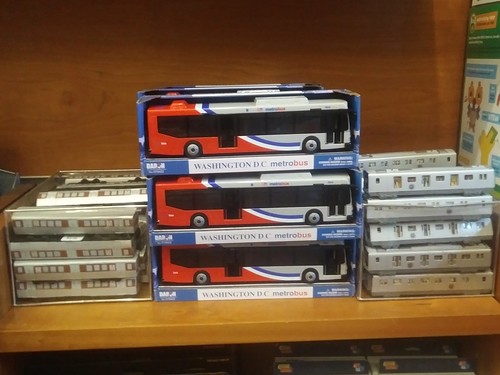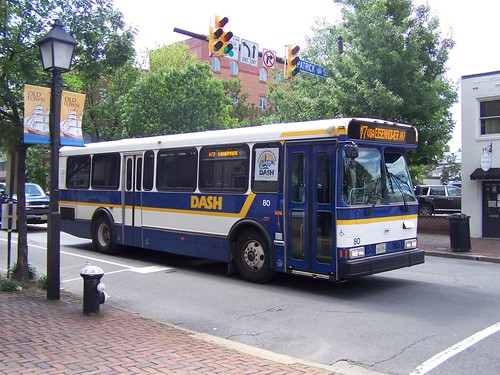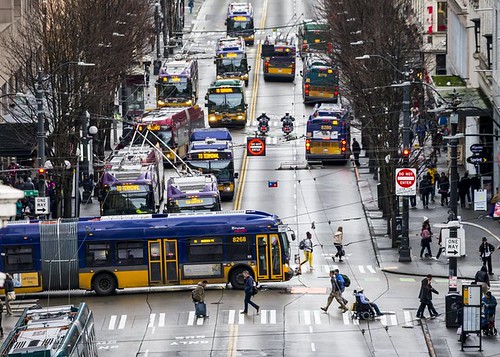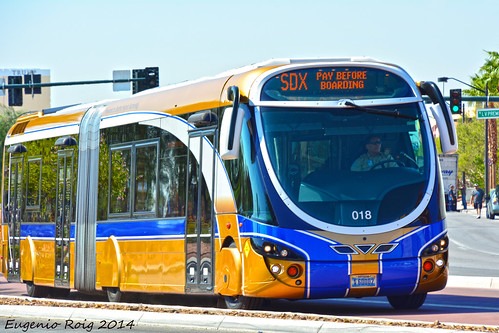Reviving DC area bus service: and a counterpoint to the recent Washington City Paper article
-- "What Lessons Can D.C. Glean From Richmond's Bus Overhaul?"
(Metrobus, especially in DC, already does the things that Richmond implemented.)
 Bus service is the DC area is balkanized. Cross-jurisdictional services are provided primarily by Metrobus, the bus unit of WMATA, the Washington Metropolitan Area Transit Authority, which runs the Metrorail system, which dominates the agency.
Bus service is the DC area is balkanized. Cross-jurisdictional services are provided primarily by Metrobus, the bus unit of WMATA, the Washington Metropolitan Area Transit Authority, which runs the Metrorail system, which dominates the agency.Intra-jurisdictional services are mostly provided by jurisdiction-specific agencies, with the exception of DC and to some extent Prince George's County, Maryland, where a majority of bus service (in terms of number of riders) is provided by Metrobus.
Metrobus service is contracted and paid for by the jurisdictions, and sometimes jurisdictional policy decisions result in disconnections within "the bus service network."
 For example, Maryland Mass Transit Administration, which ultimately makes the decisions about service, pretty much refuses to fund/authorize bus services that cross the DC border, although there are some exceptions.
For example, Maryland Mass Transit Administration, which ultimately makes the decisions about service, pretty much refuses to fund/authorize bus services that cross the DC border, although there are some exceptions.As an example, this is why the 30s buses stop at Friendship Heights on the DC-Maryland border, rather than continue to Bethesda or further north.
Simultaneous with the recent failures of Metrorail, which have resulted in a loss of about 15% of daily ridership, bus service has also declined significantly, but slightly less, at 12%.
This makes sense, because many daily journeys involve legs on both subway and bus, and a drop off of Metrorail ridership means a concomitant drop in bus ridership.
Every 10-15 years, WMATA does a big bus study. Previously this had been done in the early part of the 2000s), and the most recent is the "Washington Area Bus Transformation Project," which makes a number of recommendations for improvement.
In various writings I have recommended:
1. The Metropolitan Planning Organization, not the various transit agencies, should be the primary transit planner, setting master requirements for network breadth, network depth (frequency and levels of service), and levels of quality.
2. Contract with transit agencies to provide this level of service.
-- "Without the right transportation planning framework, metropolitan areas are screwed, and that includes the DC area," 2011
-- "Metropolitan Transit Planning: Towards a Hierarchical and Conceptual Framework," 2010
-- ""Route 7 BRT proposal communicates the reality that the DC area doesn't adequately conduct transportation planning at the metropolitan-scale," 2016
3. Define the transit network in terms of networks first at the Metropolitan; Suburban: and Center City scales; and then primary; secondary; and tertiary networks within them, which is particularly relevant to bus service.
-- "The meta-regional transit network," 2009
4. To best provide service, the DC area should create a German style transport association to better plan and deliver all transit services in a more integrated fashion.
-- "The answer is: Create a single multi-state/regional multi-modal transit planning, management, and operations authority association," 2017

In Raleigh-Durham, all but one of the bus systems have rebranded as "Go Transit" i.e., GoRaleigh, GoTriangle, etc. with a common design for livery, signage, etc., but each system uses a different color.
5. The bus services should be integrated better in terms of branding and support, using the model of the services in Raleigh-Durham, North Carolina, where they provide one call center providing information for all the services, have integrated schedules, a common branding system,, etc.
-- "Making bus service sexy and more equitable," 2012
-- "Will buses ever be cool? Boston versus the Raleigh-Durham's GoTransit Model," 2017
-- "Branding's not all you need for transit," 2018
6. There should be a night network and other improvements, like dedicated transitways, better transit information, etc. (Dedicated transitways are expanding in DC.)
-- "Night and weekend transit/subway service," 2016
-- "Overnight transit service: San Francisco," 2016
-- "Night moves: the need for more night time (and weekend) transit service, especially when the subway is closed"," 2013
Alexandria's wayfinding system includes some great signs about transit options, placed on the Waterfront and at King Street Metro.

 ✺ To be fair, except for integration, customer service and branding elements, the DC area is ahead of many jurisdictions in that bus to bus transfers are free across the different agencies, which use the same transit fare card system (using the same card isn't unique, but having free transfers across systems is relatively unique).
✺ To be fair, except for integration, customer service and branding elements, the DC area is ahead of many jurisdictions in that bus to bus transfers are free across the different agencies, which use the same transit fare card system (using the same card isn't unique, but having free transfers across systems is relatively unique).✺ Bus fares are "relatively" cheap at $2 or less. (Although some systems elsewhere are even cheaper. But many are more expensive.)
✺ And effective in FY2020, which started in July, WMATA significantly reduced the price of various pass products, and with some of the Metrorail passes, bundled in bus service, when previously and rigorously, WMATA has required separate fares for each mode.
✺ Plus, because Maryland MTA is one of WMATA's funders, they use the same transit fare card system in Greater Baltimore, which means that the transit fare cards interoperate between DC and Baltimore.
✺ While I argue that the Metrobus designs are dowdy, they are improving and updating bus stop signage and schedule information. Plus phone-based schedule information is very helpful.
Nationally, bus ridership is in decline. Bus ridership rose significantly during the recession, aided in part by high gas prices. As the economy has improved and gas prices have dropped significantly, bus ridership has dropped overall, somewhat less than 2%.
-- "APTA: Public transit ridership down in 2018," Smart Cities Dive
-- "Who's on Board 2019, TransitCenter
But in the DC area specifically, ridership has novedived. But in some areas, bus ridership has risen.
Redesigning bus networks as a national trend. Over the past few years, many bus systems, including Houston, Richmond, Philadelphia, and others have reorganized their bus service, often using the services of Jarrett Walker and Associates (Jarrett also blogs at Human Transit and has a book of the same name).
-- "Improving bus service overall vs. reversing falling Metrobus ridership," 2018
Where I use the terms "network breadth" and "network depth", he calls this coverage versus ridership, although he is focusing on total usage, making the point that you ought not to criticize a transit service for providing "coverage" (breadth) and then complain about low ridership.
What he does is pretty straightforward, he puts into place a defined "high frequency network" and tries to reduce the need for transfers between lines.
Many cities have done this already, but many haven't or they haven't defined it (DC in particular has a high frequency network but it isn't defined as such).
But most all of these big redesigns haven't resulted in much increase in ridership.
But some systems have increased ridership in the face of decline. Among the exceptions, there are four that are outliers: Columbus, Ohio; Las Vegas; Richmond, Virginia; and Seattle.
Guess what, it's not rocket science.
Free transit. Columbus (a bus exclusive system) has increased ridership significantly because as part of a transportation demand management initiative, they gave free (FREE!!!!!!!!!) transit passes to Downtown workers ("Enrollment now open for free Downtown bus pass program," Columbus Underground).
More service, defined high frequency lines (usually a form of bus rapid transit). Seattle has one of the biggest bus systems in the US, and for a large system, it's one of the only ones that added significant ridership. Why? They added service.
 Seattle Times photo.
Seattle Times photo.Interestingly, King County had wacked political requirements on bus service, which required providing equal investment in extra service in the less populated county for every investment in Seattle.
So Seattle residents passed a levy for Seattle-specific service and bus line expansion.
-- Levy to Move Seattle, Seattle SDOT
-- Best Practices in Transit, Seattle Urban Mobility Plan, 2009
-- King County Metro Service Guidelines
-- King County Metro Accountability Center
Richmond is a bus exclusive system. Their story isn't particularly scintillating for big metropolitan area, but there are still some lessons. Not only did they redefine their network a la Jarrett Walker, they created a highly visible bus rapid transit line called The Pulse, and they used this introduction to do some rebranding of the transit network.

Related to what they did with the Pulse line, something I recommend as part of the creation of new transit services is the creation of a complementary program of transit network improvements to drive ridership improvements across the transit network:
-- "Setting the stage for the Purple Line light rail line to be an overwhelming success Part 1 | simultaneously introduce improvements to other elements of the transit network," 2017
-- "Using the Silver Line as the priming event, what would a transit network improvement program look like for NoVA?," 2017
Whereas most of these big bus network redesigns have resulted in minimal improvements, just a couple percentage points, the Richmond redesign has resulted in a 17% increase in ridership.
But that's on a small base, because their transit network has been pretty weak. (It's still crippled by limited interest on the part of the abutting counties to participate in the transit system.)
Making transit service more sexy. When going through some trade magazines I hadn't read, I came across an old article about the bus system in Las Vegas, and the then director made the point that attractive buses are necessary to be able to compete with other mobility services, and their introduction of double deck buses resulted in double digit increases in ridership, and significantly greater revenues, greater than the cost of the service.
-- "Using the Purple Line to rebrand Montgomery and Prince George's Counties as Design Forward," 2017

The double deck bus line serves the Strip, and it's a premium service, not unlike how before the MTA, there was a double deck bus service on Fifth Avenue in Manhattan (although that was more about demand).


What the City Paper article missed. The City Paper suggests that the DC area could learn from what they did in Richmond. I suppose it's possible. If only as a reminder of what to do.
For the Bus Transformation Study, I said it would be interesting to analyze the area's high performing bus routes as case studies and use that information as a way to improve under performing lines.
The problem with looking at Richmond is that DC and the DC area for the most part already does the things that Richmond introduced as a new program. While there are always lots of opportunities for improvement, there is a high frequency network which is quite good, at least in DC.
Although a comparable high frequency network ought to be in place in Maryland and Virginia, and there should be more cross-jurisdictional services, especially along arterials connecting Maryland and DC.
The other problem is that in the areas where transit is most effective, especially in DC's core it's also where other competitive mobility services are offered -- car sharing, bike sharing, dockless scooters, now mopeds too -- plus ride hailing (Uber and Lyft), all of which are drawing customers away from bus (and rail). (Although some studies find a positive association between bike sharing and rail transit ridership.)
-- "DC is a market leader in Mobility as a Service (MaaS)," 2018
But a major lesson from Richmond in terms of the Pulse BRT service is that you should probably have one unified brand for BRT and/or your "high frequency bus network."
By contrast, the DC area has many: (1) MetroExtra -- limited stop but not BRT; (2) Metroway, a BRT service in Alexandria and Arlington; (3) PikeRide, a branded bus service on Columbia Pike in Arlington; (4) REX, a branded bus service on Richmond Highway; (5) RideOn Extra, a limited stop service in Montgomery County; (6) a separately planned BRT system for Montgomery County; (7) a separately planned BRT line on Leesburg Pike in Fairfax County; etc.
(Sometimes there are advantages to backwardness, a la Gerschenkron's Economic backwardness in historical perspective.)
 Other examples of differentiated and clear branding are Metro in Los Angeles' branding of rapid (red) and local (orange) buses, and how MARTA in Atlanta is rebranding as ATL ("MARTA is about to become The ATL. What do you think of the new bus design and logo?," Georgia Sun).
Other examples of differentiated and clear branding are Metro in Los Angeles' branding of rapid (red) and local (orange) buses, and how MARTA in Atlanta is rebranding as ATL ("MARTA is about to become The ATL. What do you think of the new bus design and logo?," Georgia Sun).But sure, the DC area needs to (1) better define and integrate the bus network; (2) rebrand the bus agencies and redesign bus livery; (3) market the hell out of it; (4) systematically improve the service; (5) including shifting to double deck buses and other types of design forward buses; (6) defining and providing a night bus network; etc.
And that could probably result in double digit increases in ridership.
Expand the rail network to increase bus ridership. But the biggest thing would be to not only get Metrorail "Back to Good," it would be to expand and intensify Metrorail service, to make it and the transit network more useful, by increasing both its breadth and depth. Bus service complements and extends the subway and (eventually) light rail network.
-- "Redundancy, engineered resilience, and subway systems: Metrorail failures will increase without adding capacity in the core," 2016

Conceptual Future integrated rail transit service network for the Washington DC National Capitol Region. Design by Paul J. Meissner. Concept by Richard Layman and Paul Meissner.
Improving bus ridership in the DC area. These were the points I made in "Improving bus service overall vs. reversing falling Metrobus ridership," 2018:
1. The impact of the sustainable mobility platform on use of mass transit services.
2. (As the area improves economically) Is the pool of transit dependent riders shrinking?
3. The DC area bus transit "network" is not perceived as a system/it is illegible.
4. Reposition bus service as a premium (design) product.
5. Rearticulate and reconfigure bus transit across the metropolitan area into one integrated system.
6. Make provision of dedicated bus transitways (and traffic signal prioritization for buses) a priority.
7. Create a overnight transit network at the metropolitan scale.
8. Don't forget bus services when creating HOT Lanes.
9. Rearticulate long distance commuter bus services too.
========
Primary Strategies from the Bus Transformation Study:
1. Customer focused.
2. Prioritizing buses on roads.
3. Frequent, reliable, convenient bus service.
4. Balancing the responsibilities of local and regional providers.
5. Streamlining back office functions and sharing innovation.
6. Transforming and incorporating changes in bus service.
Umm, wow.
Labels: bus rapid transit, bus transit, busways/transitways, sustainable mobility platform, transit marketing, transportation planning





0 Comments:
Post a Comment
<< Home